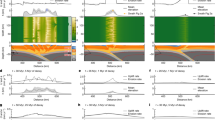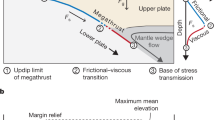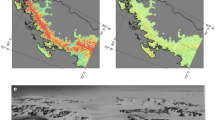Abstract
The height of mountain ranges reflects the balance between tectonic rock uplift, crustal strength and surface denudation. Tectonic deformation and surface denudation are interdependent, however, and feedback mechanisms—in particular, the potential link to climate—are subjects of intense debate1,2. Spatial variations in fluvial denudation rate caused by precipitation gradients are known to provide first-order controls on mountain range width, crustal deformation rates and rock uplift3,4. Moreover, limits to crustal strength5 are thought to constrain the maximum elevation of large continental plateaus, such as those in Tibet and the central Andes. There are indications that the general height of mountain ranges is also directly influenced by the extent of glaciation through an efficient denudation mechanism known as the glacial buzzsaw6,7,8,9. Here we use a global analysis of topography and show that variations in maximum mountain height correlate closely with climate-controlled gradients in snowline altitude for many high mountain ranges across orogenic ages and tectonic styles. With the aid of a numerical model, we further demonstrate how a combination of erosional destruction of topography above the snowline by glacier-sliding and commensurate isostatic landscape uplift caused by erosional unloading can explain observations of maximum mountain height by driving elevations towards an altitude window just below the snowline. The model thereby self-consistently produces the hypsometric signature of the glacial buzzsaw, and suggests that differences in the height of mountain ranges mainly reflect variations in local climate rather than tectonic forces.
This is a preview of subscription content, access via your institution
Access options



Similar content being viewed by others
References
Whipple, K. X., Kirby, E. & Brocklehurst, S. H. Geomorphic limits to climate-induced increases in topographic relief. Nature 401, 39–43 (1999)
Whipple, K. X. The influence of climate on the tectonic evolution of mountain belts. Nature Geosci. 2, 97–104 (2009)
Beaumont, C., Fullsack, P. & Hamilton, J. in Thrust Tectonics (ed. McClay, K. R.) 1–18 (Chapman & Hall, 1992)
Willett, S. D. Orogeny and orography: the effects of erosion on the structure of mountain belts. J. Geophys. Res. 104, 28957–28981 (1999)
Beaumont, C., Jamieson, R. A., Nguyen, M. H. & Medvedev, S. Crustal channel flows: 1. Numerical models with application to the tectonics of the Himalayan-Tibetan orogen. J. Geophys. Res. 109, B06406 (2004)
Brozovic, N., Burbank, D. & Meigs, A. Climatic limits on landscape development in the northwestern Himalaya. Science 276, 571–574 (1997)
Montgomery, D. R., Balco, G. & Willett, S. D. Climate, tectonics, and the morphology of the Andes. Geology 29, 579–582 (2001)
Mitchell, S. G. & Montgomery, D. R. Influence of a glacial buzzsaw on the height and morphology of the Cascade Range in central Washington State, USA. Quat. Res. 65, 96–107 (2006)
Foster, D., Brocklehurst, S. H. & Gawthorpe, R. L. Small valley glaciers and the effectiveness of the glacial buzzsaw in the northern Basin and Range, USA. Geomorphology 102, 624–639 (2008)
Molnar, P. & England, P. Late Cenozoic uplift of mountain ranges and global climate change: chicken or egg? Nature 346, 29–34 (1990)
Brocklehurst, S. H. & Whipple, K. X. Glacial erosion and relief production in the Eastern Sierra Nevada, California. Geomorphology 42, 1–24 (2002)
Shuster, D. L., Ehlers, T. A., Rusmoren, M. E. & Farley, K. A. Rapid glacial erosion at 1.8 Ma revealed by 4He/3He thermochronometry. Science 310, 1668–1670 (2005)
Berger, A. L. & Spotila, J. A. Denudation and deformation in a glaciated orogenic wedge: the St. Elias orogen, Alaska. Geology 36, 523–526 (2008)
Paterson, W. S. B. The Physics of Glaciers 3rd edn (Butterworth-Heinemann, 1994)
Brocklehurst, S. H. & Whipple, K. X. Hypsometry of glaciated landscapes. Earth Surf. Process. Landforms 29, 907–926 (2004)
Farr, T. G. et al. The Shuttle Radar Topography Mission. Rev. Geophys. 45 RG2004 10.1029/2005RG000183 (2007)
Broecker, W. S. & Denton, G. H. The role of ocean-atmosphere reorganizations in glacial cycles. Geochim. Cosmochim. Acta 53, 2465–2501 (1989)
National Snow and Ice Data Center. World glacier inventory (2009). 〈http://nsidc.org/data/docs/noaa/g01130_glacier_inventory〉.
Stern, T. A., Baxter, A. K. & Barrett, P. J. Isostatic rebound due to glacial erosion within the Transantarctic Mountains. Geology 33, 221–224 (2005)
Brocklehurst, S. H. & Whipple, K. X. Assessing the relative efficiency of fluvial and glacial erosion through simulation of fluvial landscapes. Geomorphology 75, 283–299 (2006)
Roering, J. J., Kirchner, J. W. & Dietrich, W. E. Evidence for nonlinear, diffusive sediment transport and implications for landscape morphology. Wat. Resour. Res. 35, 853–870 (1999)
Montgomery, D. R. Valley incision and the uplift of mountain peaks. J. Geophys. Res. 99, 13913–13921 (1994)
Anderson, R. S. Modeling of tor-dotted crests, bedrock edges and parabolic profiles of the high alpine surfaces of the Wind River Range, Wyoming. Geomorphology 46, 35–58 (2002)
Small, E. E. & Anderson, R. S. Pleistocene relief production in Laramide Mountain Ranges, western U.S. Geology 26, 123–126 (1998)
Munroe, J. S. Investigating the spatial distribution of summit flats in the Uinta Mountains of northeastern Utah, USA. Geomorphology 75, 437–449 (2006)
Brocklehurst, S. H. & Whipple, K. X. Response of glacial landscapes to spatial variations in rock uplift rate. J. Geophys. Res. 112 F02035 10.1029/2006JF000667 (2007)
Harbor, J. M., Hallet, B. & Raymond, C. F. A numerical model of landform development by glacial erosion. Nature 333, 347–349 (1988)
MacGregor, K. R., Anderson, R. S., Anderson, S. P. & Waddington, E. D. Numerical simulations of glacial-valley longitudinal profile evolution. Geology 28, 1031–1034 (2000)
Tomkin, J. H. & Braun, J. The influence of alpine glaciation on the relief of tectonically active mountain belts. Am. J. Sci. 302, 169–190 (2002)
Baral, D. R., Hutter, K. & Greve, R. Asymptotic theories of large-scale motion, temperature, and moisture distribution in land-based polythermal ice sheets: A critical review and new developments. Appl. Mech. Rev. 54, 215–256 (2001)
Harbor, J. M., Hallet, B. & Raymond, C. F. A numerical model of landform development by glacial erosion. Nature 333, 347–349 (1988)
Braun, J., Zwartz, D. & Tomkin, J. A new surface-processes model combining glacial and fluvial erosion. Ann. Glaciol. 28, 282–290 (1999)
MacGregor, K. R., Anderson, R. S., Anderson, S. P. & Waddington, E. D. Numerical simulations of glacial-valley longitudinal profile evolution. Geology 28, 1031–1034 (2000)
Jamieson, S. S. R., Hulton, N. R. J. & Hagdorn, M. Modelling landscape evolution under ice sheets. Geomorphology 97, 91–108 (2008)
Tomkin, J. H. Numerically simulating alpine landscapes: the geomorphologic consequences of incorporating glacial erosion in surface process models. Geomorphology 103, 180–188 (2009)
Baral, D. R., Hutter, K. & Greve, R. Asymptotic theories of large-scale motion, temperature, and moisture distribution in land-based polythermal ice sheets: a critical review and new developments. Appl. Mech. Rev. 54, 215–256 (2001)
Hooke, R. L. Flow law for polycrystalline ice in glaciers: comparison of theoretical predictions, laboratory data, and field measurements. Rev. Geophys. Space Phys. 19, 664–672 (1981)
Paterson, W. S. B. The Physics of Glaciers 3rd edn (Butterworth-Heinemann, 1994)
Budd, W. F., Keage, P. L. & Blundy, N. A. Empirical studies of ice sliding. J. Glaciol. 23, 157–170 (1979)
Bindschadler, R. The importance of pressurized subglacial water in separation and sliding at the glacier bed. J. Glaciol. 29, 3–19 (1983)
Harbor, J. M. Application of a general sliding law to simulating flow in a glacier cross-section. J. Glaciol. 38, 182–190 (1992)
Hallet, B. Glacial quarrying: a simple theoretical model. Ann. Glaciol. 22, 1–8 (1996)
Humphrey, N. F. & Raymond, C. F. Hydrology, erosion and sediment production in a surging glacier: Variegated Glacier, Alaska, 1982-83. J. Glaciol. 40, 539–552 (1994)
Roering, J. J., Kirchner, J. W. & Dietrich, W. E. Evidence for nonlinear, diffusive sediment transport and implications for landscape morphology. Wat. Resour. Res. 35, 853–870 (1999)
Pelletier, J. Quantitative Modeling of Earth Surface Processes (Cambridge Univ. Press, 2008)
Acknowledgements
We thank K. Hutter and N. Kirchner for assistance with the implementation of the SOSIA. We also thank C. Clark, J. A. Piotrowski, B. H. Jacobsen, M. Sandiford, R. Brown and O. Humlum for comments. J. Braun and S. Brocklehurst are thanked for reviews that improved the manuscript considerably.
Author Contributions D.L.E. and S.B.N. designed the study. V.K.P. and D.L.E. performed the global topographic analysis. D.L.E. implemented the SOSIA and performed the numerical modelling. All four authors contributed to writing the paper in the order listed.
Author information
Authors and Affiliations
Corresponding author
Supplementary information
Supplementary Information
This file contains Supplementary Figures S1-S12 with Legends, Supplementary Data and Supplementary References. (PDF 13914 kb)
Rights and permissions
About this article
Cite this article
Egholm, D., Nielsen, S., Pedersen, V. et al. Glacial effects limiting mountain height. Nature 460, 884–887 (2009). https://doi.org/10.1038/nature08263
Received:
Accepted:
Issue Date:
DOI: https://doi.org/10.1038/nature08263
This article is cited by
-
Overdeepenings in the Swiss plateau: U-shaped geometries underlain by inner gorges
Swiss Journal of Geosciences (2023)
-
Medieval demise of a Himalayan giant summit induced by mega-landslide
Nature (2023)
-
Ice flux of alpine glaciers controls erosion and landscape in the Nianbaoyeze Shan, northeastern Tibetan Plateau
Journal of Mountain Science (2023)
-
Geomorphic controls on debris flow activity in the paraglacial zone of the Southeast Tibetan Plateau
Natural Hazards (2023)
-
The extreme yet transient nature of glacial erosion
Nature Communications (2022)
Comments
By submitting a comment you agree to abide by our Terms and Community Guidelines. If you find something abusive or that does not comply with our terms or guidelines please flag it as inappropriate.



